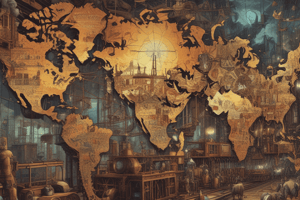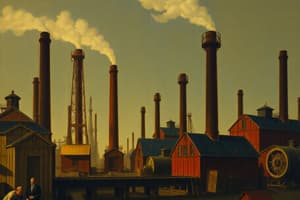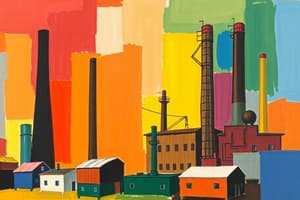Podcast
Questions and Answers
What did Mark Twain refer to as the 'Gilded Age'?
What did Mark Twain refer to as the 'Gilded Age'?
- A period of agricultural prosperity and wealth distribution
- An era of political stability and social equality
- A period of extremes with vast fortunes for a few and squalor for many (correct)
- A time of great technological advancements in the United States
What transformation occurred in the American economy by 1900?
What transformation occurred in the American economy by 1900?
- Rise of small-scale artisan businesses
- Increase in the number of mega-farms
- Shift from farm-based to factory-based economy (correct)
- Transition from manufacturing to agricultural economy
What characterized manufacturing in the Second Industrial Revolution?
What characterized manufacturing in the Second Industrial Revolution?
- Greater focus on employee well-being and satisfaction
- Increasing reliance on machines and unskilled labor (correct)
- Continued emphasis on skilled artisanal work
- Shift towards decentralized small-scale production
How were injured, ill, or dissatisfied workers viewed in the factories of the Second Industrial Revolution?
How were injured, ill, or dissatisfied workers viewed in the factories of the Second Industrial Revolution?
What effect did innovations in technology, materials, and management have on industry during the Second Industrial Revolution?
What effect did innovations in technology, materials, and management have on industry during the Second Industrial Revolution?
Who enjoyed vast fortunes and fabulous mansions during the Gilded Age?
Who enjoyed vast fortunes and fabulous mansions during the Gilded Age?
What was the primary source of livelihood for most Americans in the mid-1800s?
What was the primary source of livelihood for most Americans in the mid-1800s?
What was the average annual income of a male, non-farm employee in the year 1900?
What was the average annual income of a male, non-farm employee in the year 1900?
How much did the young girl in the cotton mill earn per day according to the photographer Lewis Hine?
How much did the young girl in the cotton mill earn per day according to the photographer Lewis Hine?
What was one of the worst industrial accidents in American history that took place in a factory?
What was one of the worst industrial accidents in American history that took place in a factory?
What was the primary reason for the decrease in child labor near the end of the period?
What was the primary reason for the decrease in child labor near the end of the period?
What was the average workday for industrial employees in 1880?
What was the average workday for industrial employees in 1880?
What was the average annual income of a male immigrant worker in the year 1900?
What was the average annual income of a male immigrant worker in the year 1900?
How many workers were killed on the job in 1900?
How many workers were killed on the job in 1900?
What led to the improvement in working conditions for industrial workers in the mid-1880s?
What led to the improvement in working conditions for industrial workers in the mid-1880s?
What was the average annual income of a male, non-farm industrial employee in 1900?
What was the average annual income of a male, non-farm industrial employee in 1900?
What event led to the passing of regulations in New York requiring outward-swinging doors and unlocked doors during business hours?
What event led to the passing of regulations in New York requiring outward-swinging doors and unlocked doors during business hours?
What was the primary reason for the decrease in child labor during the Second Industrial Revolution?
What was the primary reason for the decrease in child labor during the Second Industrial Revolution?
What was the primary focus of the labor unions that American workers began organizing in the mid-1880s?
What was the primary focus of the labor unions that American workers began organizing in the mid-1880s?
What were the primary challenges faced by industrial laborers in the early 20th century?
What were the primary challenges faced by industrial laborers in the early 20th century?
What was the impact of the Second Industrial Revolution on the American economy?
What was the impact of the Second Industrial Revolution on the American economy?
What was the primary reason for the formation of labor unions by American workers?
What was the primary reason for the formation of labor unions by American workers?
What led to the creation of a federal department for occupational safety in the United States?
What led to the creation of a federal department for occupational safety in the United States?
Flashcards are hidden until you start studying
Study Notes
The Impact of Industrialization on American Workers
- In 1880, five million Americans were industrial employees, including immigrants, women, and children who were paid less than American men.
- The average male, non-farm employee in 1900 made about $483 a year, equivalent to about $13,000 in today's dollars, working six days a week, ten hours a day.
- Female immigrants earned less, women might get half that rate, and children were lucky to get a third.
- Industrial laborers faced long hours, low pay, and dangerous working conditions with as many as 35,000 workers killed and another million injured on the job in 1900.
- The Triangle Shirtwaist Factory fire in 1911 resulted in the death of 146 people, mostly young Jewish and Italian immigrant women.
- The fire led to the passing of regulations in New York that required outward-swinging doors and unlocked doors during business hours, ultimately leading to the creation of a federal department for occupational safety.
- Industrial workers received almost no protection from the government until the early 20th century, with labor having almost no bargaining power over management.
- American workers began organizing labor unions in the mid-1880s to increase their leverage and improve working conditions.
- Child labor decreased due to the expansion of compulsory high school education and the introduction of a system called 'scientific management' that aimed to increase factory output.
- The Second Industrial Revolution introduced white-collar jobs and growth in the middle class, creating opportunities for skilled workers in designing, fabricating, and overseeing production.
- The impact of industrialization was not limited to factory workers, as agricultural laborers faced similar circumstances, whether on their own land, as tenant farmers, or as seasonal employees.
- Despite the challenges, working conditions gradually improved in small steps, with the formation of labor unions and the passing of regulations to protect workers.
Studying That Suits You
Use AI to generate personalized quizzes and flashcards to suit your learning preferences.





